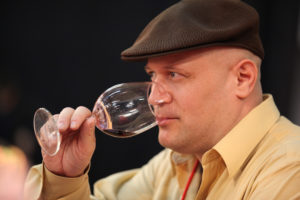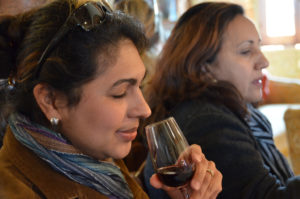You see it often in wine tasting notes: “the wine is complex”, or something along those lines. But what does “complexity” in wine mean? Is it complex because of the number of compounds contributing to the flavors/aromas and structure of the wine? Or is it complex because of what we perceive to be tasting/feeling when we drink the wine? Or is it a combination of these or something completely different? The answer isn’t straightforward, with the definition of complexity in wine being different for different people.

Photo courtesy Flickr user StateofIsrael
For many in the wine business, complexity in wine refers to the combination of flavors and aromas in a wine evolving over the course of a tasting session. The Wine & Spirits Education Trust (WSET), “complexity is a desired feature in a wine and one which can result from fruit character alone or from a combination of primary, secondary and tertiary aromas and flavors.” However, it’s not as simple as plainly stating that a wine in and of itself is complex. WSET doctrine continues, “only use the word ‘complex’ with context. It is not enough to say whether a wine is complex or not; you have to explain what provides the complexity.” (Note: WSET definitions and quotes taken from the WSET Level 4 Diploma in Wine and Spirits, Part 2: Tasting document that can be found as a PDF here).
In academic literature, complexity in wine is an ongoing topic of study and one that has been met with mixed results. In general, studies seem to support the idea that complexity in wine is related to the number of aromas/flavors, balance, finish, etc., though understanding of the concept seems to differ between trained professionals and the average consumer (which shouldn’t be too surprising).
A new exploratory study, available online now and in print in the September 2018 issue of Food Quality and Preference, aimed to investigate how complexity in wine is perceived by “social drinkers”, with an attempt to identify specifically what characteristics were associated with the concept of complexity in wine.
Brief Methods
18 people (7 women, 11 men) participated in this study and were between the ages of 28 and 62 years old. Participants were researchers in art history, music, psychology, philosophy, and neuroscience at Somerville College in the UK.
A total of 8 wines were tasted in the study, presented in 3 flights.
Flight 1: 3 white wines, intended to showcase different definitions of complexity.
Flight 2: 3 red wines, 1 single variety, 1 that same variety but in a blend, and the same blend after aging.

Photo courtesy Flickr user Trevor Leyenhorst
Flight 3: 2 sweet wines, same grapes, different winemaking techniques (same winery).
Participants were presented each flight one at a time and tasted them in the same order. Tastings were blind, with the wines not revealed to participants until after the exercise was complete.
For flight 1: Participants rated their liking of each wine, aromas and flavors they perceived, quality, and complexity.
For flights 2 and 3: Participants did the same thing as with flight 1, but also were asked to note when they perceived each aroma/flavor during the tasting session.
Participants also self-reported their level of wine expertise.
Participants tasting notes were evaluated using the Python Natural Language Toolkit (if you want to geek out with this method, see their website here).
Selected Results
- All but one of the participants reported a basic or novice level of wine expertise. The odd person out reported as intermediate.
- Complexity correlated with wine liking, quality, and the number of perceived flavors.
- Wine type significantly influence liking, complexity, and the number of perceived flavors.
- Fewer flavors noted in dry white wines.
- Dry white wines were less liked than the red and sweet wines.
- Wine type did not influence perception of quality (so while the participants may not have liked the white wines as much, this did not influence their perception of the quality of those wines).
- Wine price correlated with perceived quality, but NOT with complexity or the number of perceived flavors.
- Numbers of perceived aromas correlated with the numbers of perceived flavors.
- For white wines, number of perceived aromas or flavors did not correlate with complexity.
- Numbers of perceived flavors before swallowing was not correlated with the numbers of perceived flavors after swallowing.
- Numbers of perceived flavors before swallowing was correlated with complexity, but NOT the numbers of perceived flavors after swallowing.
- Certain flavor descriptors were found more often in complex wines than simple wines.
- “Smoke” was the term most likely found in a description for a wine deemed complex by participants. Odds were 7.6 to 1 that the word “smoke” would be found in a complex wine tasting note than a simple wine tasting note.
- The following were the top 10 wine descriptors more likely to be found in a complex wine tasting note: smoke, resin, vanilla, mineral, earth, cherry, meat, liquorice, sweet, and cranberry. (Odds ratios, respectively: 8, 2.4, 2.4, 2.2, 1.7, 1.7, 1.7, 1.7, 1.6, and 1.6 to 1).
- Language analysis found that participants used more consistent language when describing complex wines compared with describing simple wines.
- Similarly, participants used more consistent language when describing wines they liked compared to wines they didn’t like.
- On the other hand, participants used more consistent language when describing low quality wines compared to high quality wines.
- The top three wine descriptors noted for complex wines were associated with oak aging.
Conclusions
Overall, this study provides a glance into the concept of wine complexity with novice wine consumers. As the official WSET definition describes, participants perceived a complex wine as one with larger numbers of flavors/aromas. Of course, participants were self-reported novices, so in theory they have never read trade definitions of wine terms. This appears to be a rather self-explanatory definition in a way—more flavors? More complex.
What I found more interesting than the correlation analysis, however, was the language analysis of the tasting notes written by the participants. This analysis showed that participants tended to be more consistent with their descriptions of complex wines than simple wines, which is opposite of what I would have guessed. Was it just easier for this group to pick out certain flavor types in the more complex wines for some reason? Or are they pulling from what little knowledge they have about wine tasting and regurgitate it on paper when they wouldn’t have known what else to write? Similarly, the group tended to use more consistent

Photo courtesy USAG Livorno PAO
language with wines they liked compared with wines they did not like. This one makes some sense to me, as perhaps even though their wine knowledge is limited, they do know what flavors they like in wine and therefore are better able to describe those than wines/flavors they do not like. Finally, I’m tripped up a little bit with the finding that language usage was more consistent to describe low quality wines than higher quality wines. Somehow, they are better able to pick out what makes a low quality wine bad and less able to describe what makes a high quality wine good? Interesting analysis overall, to say the least.
As this is a small, exploratory study, there are many limitations to be considered. Here are just three of them:
First, the sample size was tiny. With only 18 people in the study, it is impossible to scale up the results to a whole region or other sub-set of wine consumers.
Second, the sample only contained wine novices. If the wine novice is the focus of your study, then great, but you still need to have a sort of control that is not a wine novice (say another group, like wine experts or a group with intermediate level knowledge). Are the results typical of all wine drinkers? Or just novices? There is no basis for comparison here.
Finally, only 8 wines were tasted. The researchers did a respectable job trying to find wines representative of the characteristics they were hoping to compare/contrast, but even still, there is no way to scale up to all wines based on a small sample of 8. Perhaps the results were not a function of the wine tasters but of these specific wine samples.
All that said, this was intended to be an exploratory study, so the researcher made no such claims to be able to scale up to mass wine consumers. In fact, they admitted the results could be very study-specific, however, some of their results did support other research done in the field, indicating that there might be some merit to the results.
Overall, I thought the study and its results were interesting, and would be interested in seeing it performed on a much larger scale, and one more representative of the consumer wine market (either regional, or global).

4 comments for “An Academic Foray Into Complexity in Wine: An Analysis of Language”